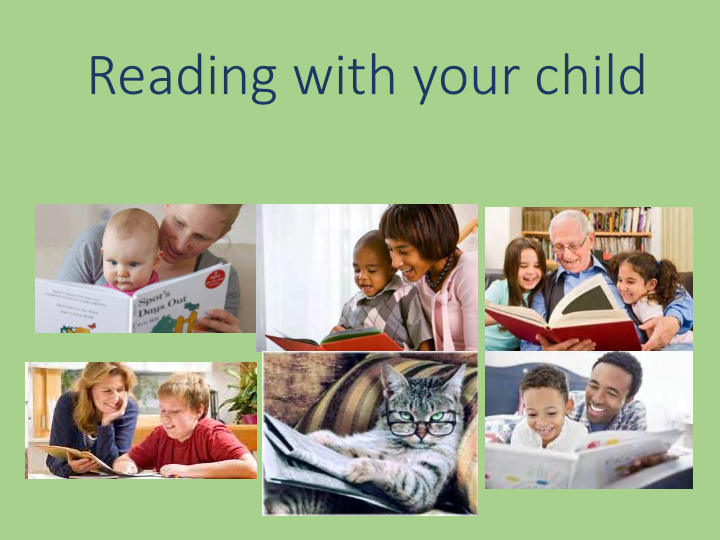



Reading with your child
Steps to reading • Talking – chatting lots and lots and lots (and listening too) • Breaking the code – decoding • Fluency – punctuation • Understanding
chatting • The more words your child knows and uses in everyday life – the easier reading is. • Developing vocabulary including categorising – e.g how many words for fruit does your child know? How many types of transport? • Developing listening skills • Developing memory – both listening and visual
Breaking the code • Many words can be ‘sounded out’ Phonics • 44 phonemes • 26 letters – combinations of the letters make up the rest • Pure sounds • Some words are not phonetic - said, would • For longer words – syllables • Beats in a word to split up the word
Reading fluently and expressively You are an important role model Talking in sentences leads to reading in sentences which leads to writing in sentences. • Making silly voices when there is talking in a story • Emphasising some words for effect – changing your voice as you go • Use facial expressions and actions • Read the book to your child before they have a go. Model how to read a sentence if they get stuck • Re-read a short book several times so they can practice this. Or re-read a few sentences.
Understanding • Asking questions – finding information • Who, what where, when? How do you know they • How do you know that? understand? • How, why? Inference – clue finding • What do you think will happen next? – prediction • Why do you think? – their opinion • What does that word mean? Can you find a word that means….? • Why do you think that word has been used there? • What has just been happening? Summarising • If you were that character - how would you feel/ what would you do? Etc • Turn the tables - Get your child to make up a question for you to find from the text
• Only one in three UK parents read to their children every day, a new survey has found. The reason? Not because we don’t know how vital it is to introduce children to reading, but because we’re too busy and distracted.
So what can I do to help? • Join a library • Word games • Make it habit – set time every day • Rhyming games • Before bed as part of winding down • I spy • Have a dictionary and thesaurus at home for your child ( age • Words starting with the same letter appropriate) – and help your child to find out words for themselves • A to Z’s of animals etc • Invite your child to make up their • Reading to your child – everything own story - maybe give them a prop when out and about, recipes, like a doll or a picture as a jumping gardening, on-line, researching off point. • Keep audio-books in the car to • Video your child telling their story develop children’s listening skills - or and play it back to them, or write a tell a story you know well while story book together all about them. you’re driving. • Keep reading to them until the end • Audio books from the library of junior school
Practical strategies • Speed reading words – how many in a minute • Pause, prompt, praise • 3 books on the go • Reading beyond their ability 5 mistakes on a page – the text is too hard for them to read independently • Book sharing
So what can stop your child being successful at reading? • Hearing? • Sight? • Regular opportunity to talk and listen • number of words they know • Amount of practice at reading • Speech and language difficulty • Memory difficulty – listening, visual, working • Visual stress • Dyslexia • Dyspraxia
“The single most important activity for building the knowledge required for eventual success in reading is reading aloud to children.” • Questions? Sitting down to read a story with your child is effectively a direct message that says ‘I really like your company, I value you and I want to share time with you’. Zoe Ball
Recommend
More recommend